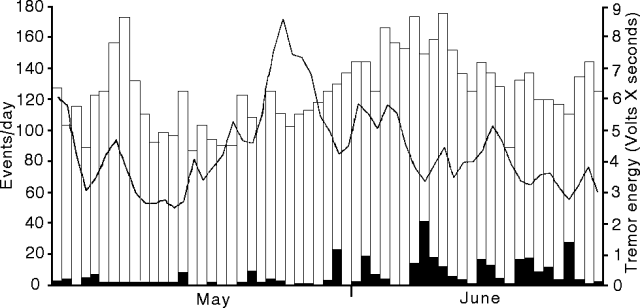Report on Stromboli (Italy) — June 1994
Bulletin of the Global Volcanism Network, vol. 19, no. 6 (June 1994)
Managing Editor: Richard Wunderman.
Stromboli (Italy) Variable seismicity, but generally low; moderate-low activity in late May
Please cite this report as:
Global Volcanism Program, 1994. Report on Stromboli (Italy) (Wunderman, R., ed.). Bulletin of the Global Volcanism Network, 19:6. Smithsonian Institution. https://doi.org/10.5479/si.GVP.BGVN199406-211040
Stromboli
Italy
38.789°N, 15.213°E; summit elev. 924 m
All times are local (unless otherwise noted)
Visual observations made by volcano guides in April indicated moderate activity, in terms of both the number and vigor of the eruptions; pyroclastic material rarely reached the crater rims. Field work was carried out by R. Carniel, F. Iacop, and G. Salemi (Univ of Udine) during 21-26 May to study the correlation of external activity with seismicity. Activity at the middle crater (C2) during this period consisted of fumarolic emission, without explosions or strong degassing. The lava pond in the pit of the SW crater, C3 (19:03), displayed almost continuous spattering. This activity could be distinguished by short intervals of noise during the day, and by the red light reflected by gas above the vent at night. Neither the surface of the pond nor the fumarolic vents could be seen. Two other vents closer to the SW rim of C3 were also active. The first exhibited moderate explosions. The other produced a few small explosions on 22 May, but much more vigorous activity on 24 and 25 May during the peak of tremor (figure 35), with high, black, mushroom-shaped columns; pyroclastic material fell well beyond the SW crater rim. Within the NE crater (C1), two active vents were observed. The first, in the front towards the Sciara del Fuoco, was characterized by very high and long-lasting explosions (up to 40 seconds). The second, near the boundary with C2, produced smaller explosions; during the night a pale reddish light could be seen that intensified a few seconds before the explosions began.
Following increased seismic activity in December 1993 and January 1994 (19:01), seismicity was fairly constant through February and early March (<150 events/day), except for a brief increase during the last week of February (150-200 events/day). On 10 March, the number of seismic events/day increased into the 200-250 range, and remained at that level through the end of the month. Starting on 12 March, tremor energy showed a general decrease, and the number of stronger seismic events increased. This pattern has been observed several times in the past. The summit visits by Boris Behncke on 9-12 March (19:03) took place during a period of higher seismicity and tremor energy. Seismicity decreased again on 28 March to around 200 events/day, and by 10 April the rate had declined to ~ 150 events/day; it remained stable at that level for two weeks. Tremor amplitude during this time fluctuated, but generally seemed to decrease. Tremor energy increased abruptly on 25 April, just two days before the number of daily events again decreased.
During May, tremor energy decreased and the daily number of events increased compared to April, peaking at 173 events on 8 May (figure 35). Tremor energy increased from 14 to 24 May before steadily decreasing in June. The number of recorded events increased in June, with a maximum of 175 on 10 June, and there were a considerable number of larger events. Larger events are defined as those with ground velocities >100 mm/second, saturating the seismic station located very close to the crater area.
Geological Summary. Spectacular incandescent nighttime explosions at Stromboli have long attracted visitors to the "Lighthouse of the Mediterranean" in the NE Aeolian Islands. This volcano has lent its name to the frequent mild explosive activity that has characterized its eruptions throughout much of historical time. The small island is the emergent summit of a volcano that grew in two main eruptive cycles, the last of which formed the western portion of the island. The Neostromboli eruptive period took place between about 13,000 and 5,000 years ago. The active summit vents are located at the head of the Sciara del Fuoco, a prominent scarp that formed about 5,000 years ago due to a series of slope failures which extends to below sea level. The modern volcano has been constructed within this scarp, which funnels pyroclastic ejecta and lava flows to the NW. Essentially continuous mild Strombolian explosions, sometimes accompanied by lava flows, have been recorded for more than a millennium.
Information Contacts: R. Carniel, Univ di Udine.


